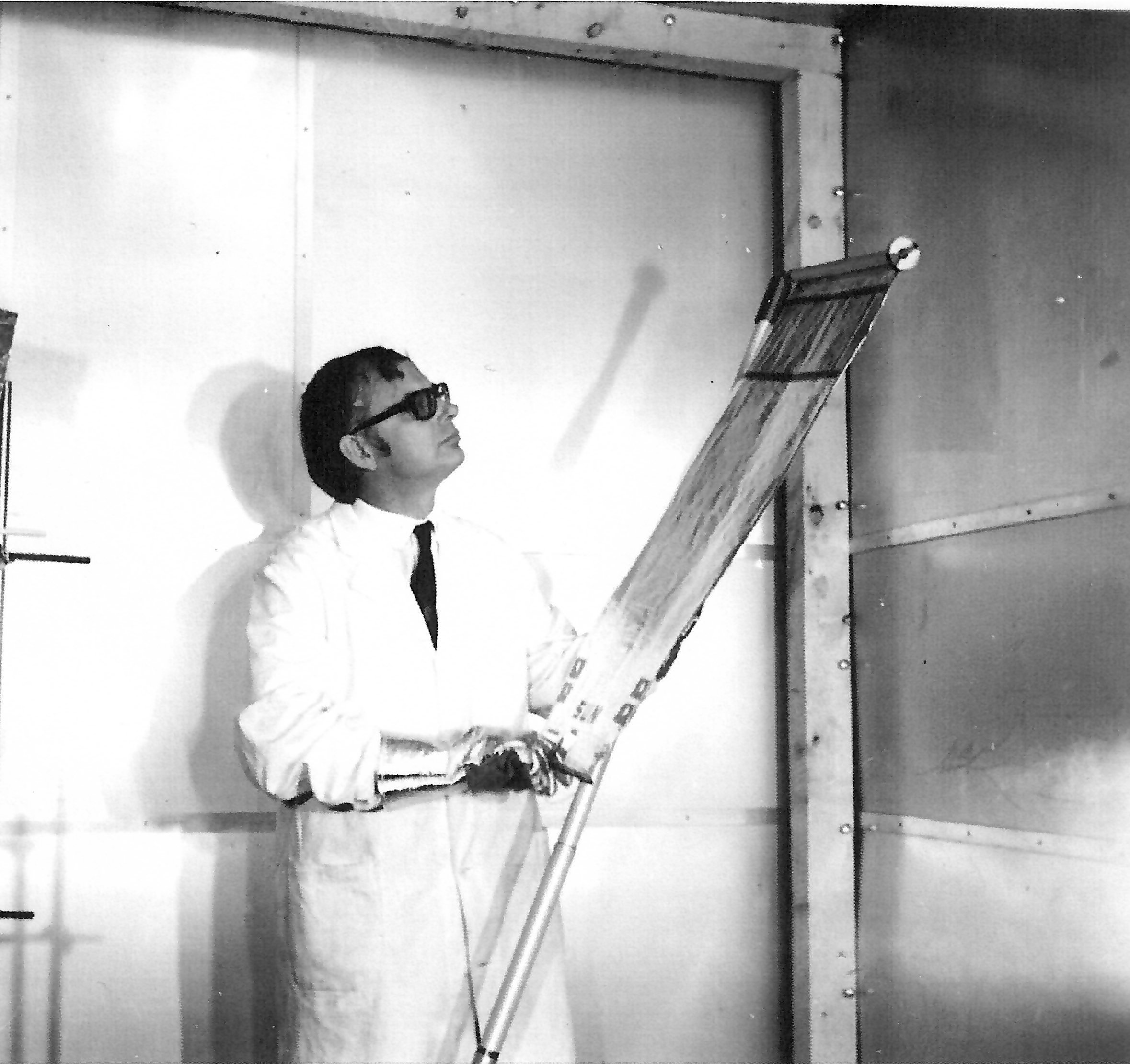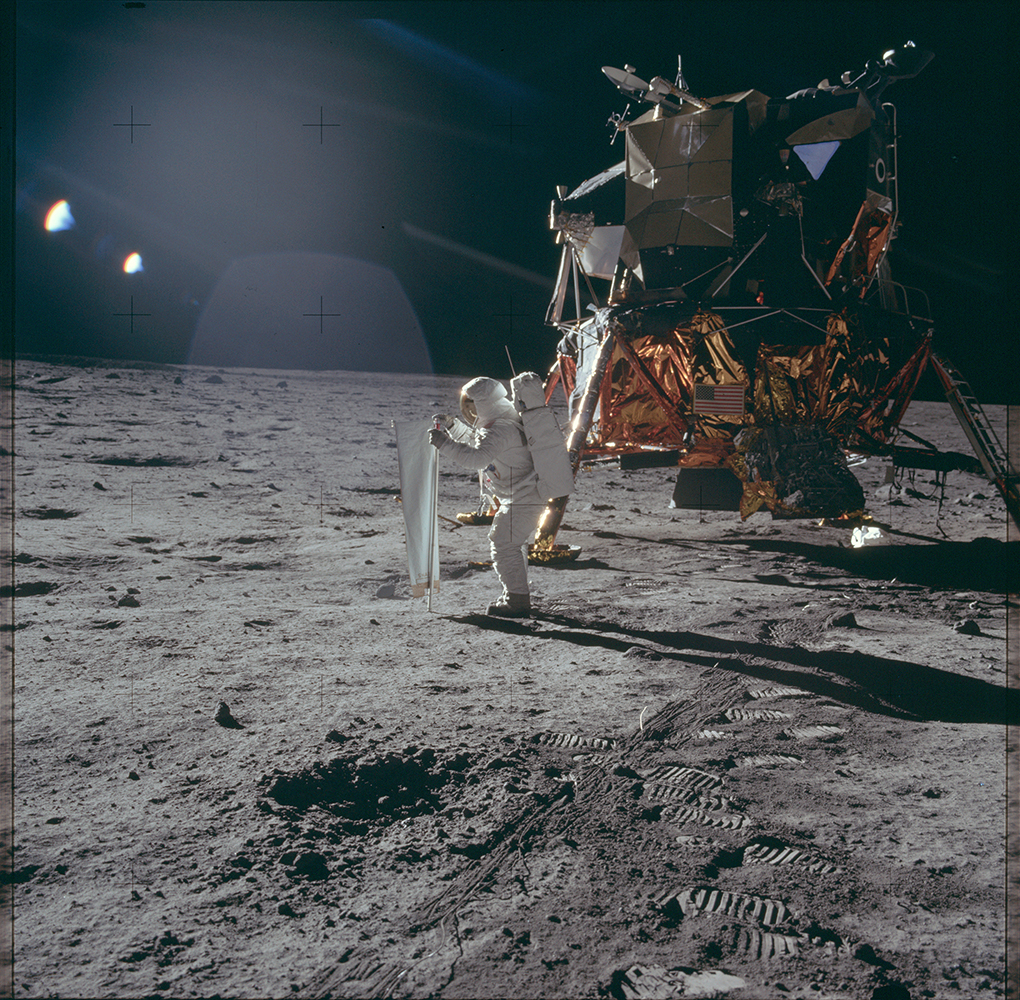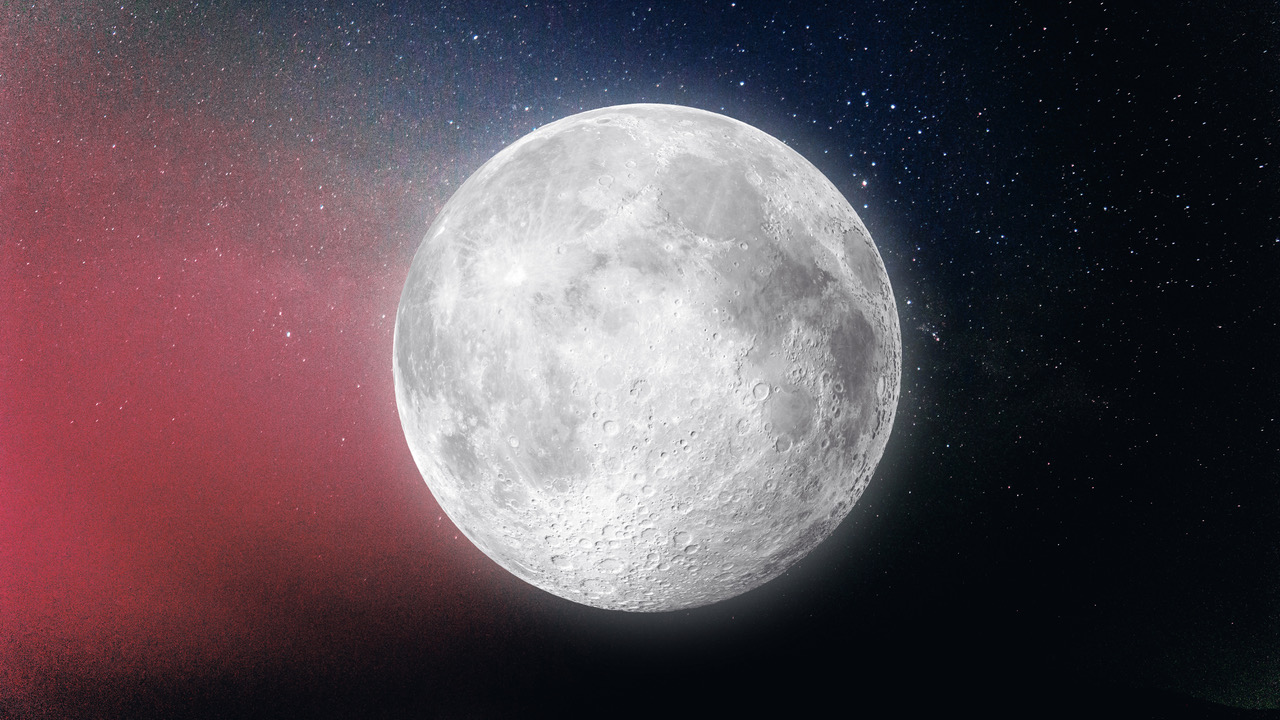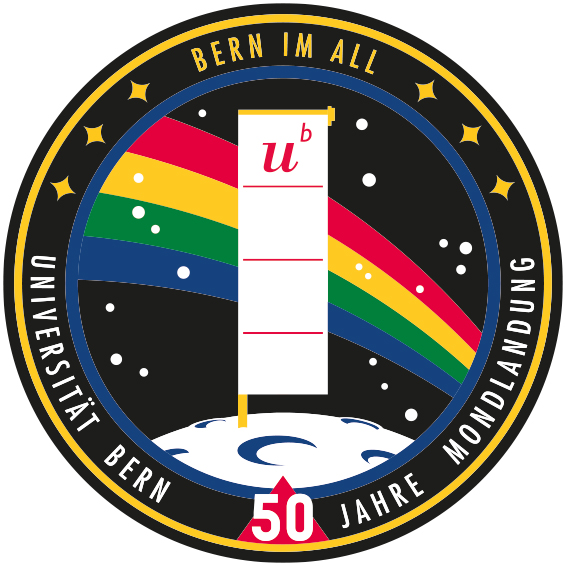Bern in Space – celebrating 50 years since the moon landing
At the end of June, the University of Bern is holding a diverse science festival to mark the occasion of the 50th anniversary of the moon landing: a multimedia show on Bundesplatz will display milestones in Bernese space exploration, high-ranking representatives from the big space agencies will discuss the future of space exploration, there will be a chance to look up at the night sky from the Grosse Schanze – and rockets will be built.
When the second man, Buzz Aldrin, stepped out of the lunar module on July 21, 1969, the first thing he did was to unfurl the Bernese solar wind sail and plant it into the ground on the moon, even before the American flag. This Solar Wind Composition experiment (SWC), which was planned and evaluated by Prof. Johannes Geiss from the Physics Institute of the University of Bern, was the first great highlight in the history of Bernese space research. Today, researchers from Bern are looking for signs of life in deep space, sending high-precision cameras to Mars and observing space debris. Plenty of reason for the city of Bern to take this summer as an opportunity to celebrate space research and the first moon landing.
Top-class symposium at the start
The anniversary celebrations start on Friday, June 28, 2019 with the symposium “Perspectives of Space Research”, which will run from 10 am to 4:30 pm in the University of Bern’s Main Building. Representatives of big organizations and institutions will discuss the future of space exploration, planned missions, scientific goals and challenges. The speakers include: Günther Hasinger (Director of Science at the European Space Agency, ESA), Thomas Zurbuchen (University of Bern alumnus and Associate Administrator for the Science Mission Directorate of the National Aeronautics and Space Administration, NASA), Ewine van Dishoeck (President of the International Astronomical Union, IAU), Pascale Ehrenfreund (Chairman of the German Aerospace Center, DLR), Xavier Barcons (Director General of the European Southern Observatory, ESO), Eckhard Elsen (Director for Research at CERN) and Nobel Prize winner Brian Schmidt.
Diverse program on Bundesplatz
The moon landing and Bernese space research will be the focus during the celebrations on the Bundesplatz in Bern. A multimedia show will take visitors away to the depths of space, past the moon and the Bernese solar wind sail, past Mars and other planets, and will show milestones in Bernese space exploration. The big questions will also be tackled: Where do we come from? Where is the origin of life? The Rocket Cube will be opened on Friday, June 28 at 5:30 pm with speeches from, among others, Mayor of Bern Alec von Graffenried and President of the Parliament of Bern, Hannes Zaugg. There will be concerts from Marius Bear and Yokko from 7 pm. The multimedia show can be visited every day for free from 10 am to 8 pm until Thursday, July 4, 2019. From 10 am until 7 pm on Sunday, June 30, 2019, the Bundesplatz will be transformed into a Space Village with short presentations on space reseach, scientific experiments, and games for young and old. Researchers from the University of Bern will offer an insight into their work and answer questions from interested parties throughout the day. There will also be a concert from the local band Traktorkestar in the afternoon.
Building rockets and stargazing at the Grosse Schanze
Between 2 pm and 6 pm on Saturday, June 29, pilots can build their own rockets from PET bottles and compete against each other. Who can fly the highest? Who can build the best rocket? From 7 pm, after the rocket building competition, the field on the Grosse Schanze will become a big observatory with dozens of telescopes. Professionals from the observatories in the Canton of Bern and the astronomical societies will explain the starry sky and take photos of the night sky with the public. Presentations by young researchers from the University of Bern, planetarium shows, and astronomical exhibits will bring extra color to the evening. A highlight will be delivered by the chief experimenters from the Physics Institute in the form of an experiments show for young and old. Both events will be adjusted in the event of bad weather.
The space nation of Switzerland in focus
A highlight of the festivities will be the event “Switzerland in Space” in the Kursaal Bern from 4 pm to 6 pm on Saturday, June 29. There will be insights into the world of research institutions and companies which have written, and continue to write, the history of space. What are the origins of Bernese space exploration, and what is the secret of its success? Which milestones have caused a stir in the last 50 years since the solar wind experiment, and what significance does space have for Switzerland as a business center? The keynote speakers are Thomas Zurbuchen, Associate Administrator for the Science Mission Directorate at NASA, and Johann-Dietrich Wörner, Director General of the ESA. In addition, young researchers will speak about why they decided to come to the University of Bern, and what research projects they have devoted themselves to. Federal Councilor Guy Parmelin, head of the Department of Economic Affairs, Education and Research, will also give a speech. Following the event, he will be available for short interviews. The event will be moderated by Katja Stauber.
“We can be justifiably proud”
“That representatives of the leading space agencies are coming to Bern to celebrate with us exemplifies the excellent network and noteworthy results that the University of Bern has achieved over the last 50 years in the field of space researcg,” says the rector, Christian Leumann. And he hopes that the public will be fascinated by space exploration. “We can be justifiably proud. The University of Bern has been involved in space missions for decades, as is currently the case with the CaSSIS camera which is supplying spectacular images from Mars, or with the CHEOPS space telescope which will be searching for exoplanets potentially capable of supporting life from fall 2019.” Leumann is also delighted that lots of Bernese culture institutions will be engaging with the moon landing and space exploration in completely different ways. “We hope that we can inspire lots of Bernese people with this supporting program.”
Invitation to the “Bern in Space” press conference
Media professionals are warmly invited to the press conference at the start of the “Bern in Space” anniversary celebrations:
Date: Friday, June 28, 8:30 am
Place: University of Bern Main Building, Room 208, Hochschulstrasse 4, 3012 Bern
The following will be participating in the media conference:
Christian Leumann: Rector of the University of Bern
Christoph Pappa: Overall project responsibility, Secretary General of the University of Bern
Willy Benz: Director of the National Centre of Competence in Research PlanetS, University of Bern
Thomas Zurbuchen: Associate Administrator for the Science Mission Directorate at NASA
Günther Hasinger: Director of Science at the ESA
Pascale Ehrenfreud: Chairman of the DLR
Following the press conference, there will be an exclusive screening of the multimedia show on the Bundesplatz. For media professionals who would like to attend the “Perspectives of Space Exploration” symposium after the press conference, a second screening will take place at midday.
Invitation to the media appointment with Federal Councilor Guy Parmelin as part of “Switzerland in Space”
Media professionals are warmly invited to the media appointment following the “Switzerland in Space” event:
Date: Saturday, June 29, 6 pm
Place: Kursaal Bern, Kornhausstrasse 3, 3000 Bern
Registration
We ask that you register by Monday, June 24, 2019 (see registration form in the download section):
medien@unibe.ch, +41 31 684 41 42
Science magazine UniPress on “Bern in Space” (in German only)The latest edition of the science magazine UniPress is dedicated to the moon landing 50 years ago and is presenting the success story of Bernese space exploration over eight special pages. https://www.unibe.ch/aktuell/magazine/unipress/aktuelle_ausgabe/index_ger.html How Bern went to the moon – by Fred Geiselmann Astronaut Charlie Duke: “We had the time of our lives” – Space race – by Julia Richers Satellites as system ambassadors – by Eva Maurer A moon landing? What moon landing? – by Roland Fischer Special pages on Bern’s space exploration – by Brigit Bucher A giant leap – or was it just a small step? – by Claus Beisbart |
Living history of space: video portraits of space researchers from Bern (in German only)They wrote space history for Bern – the scientists, engineers and workshop directors who worked at the Physics Institute of the University of Bern from the 1960s onwards. In video portraits, Kathrin Altwegg, Hans Balsiger, Peter Bochsler, Otto Eugster, Ernest Kopp, Jürg Meister and Urs Schwab, describe their experiences at the time of the Apollo missions and tell us about space missions in which they were involved. Rarely seen video footage illustrates the challenges they had to face. The only Swiss astronaut, Claude Nicollier, takes an outsider’s look at the University of Bern’s space exploration, and puts Bern’s achievements in a national and international context. http://www.bernimall.unibe.ch/hintergrund/videoportraits_zu_berner_weltraumforschenden/ |
Bernese space exploration: World-class for more than 50 yearsBernese space exploration has been working with the world’s elite for 50 years. The resulting numbers are impressive: instruments have flown into the upper atmosphere and ionosphere on rockets 25 times (1967-1993), into the stratosphere on balloons 9 times (1991-2008), more than 30 instruments have flown in space probes, and a satellite was built (CHEOPS, start of the 2nd half of 2019). The successful work of the Department of Space Research and Planetary Sciences (WP) from the Physics Institute of the University of Bern was consolidated by the foundation of a university competence center, the Center for Space and Habitability (CSH). The Swiss National Fund also awarded the University of Bern the national research focus (NFS) PlanetS , which it manages together with the University of Geneva. |
2019/06/07
Images
Download
- «Bern im All» Program (im German only) (PDF, 1.6 MB)
- «Bern im All» Booklet (in German only) (PDF, 2.8 MB)
- Science magazine UniPress on «Bern im All» (in German only) (PDF, 2.7 MB)
- Media Release and Invitation “Bern in Space” (PDF, 300KB)
- Registration form “Bern in Space” for journalists (PDF, 176KB)





